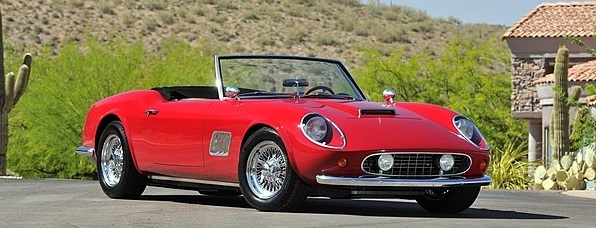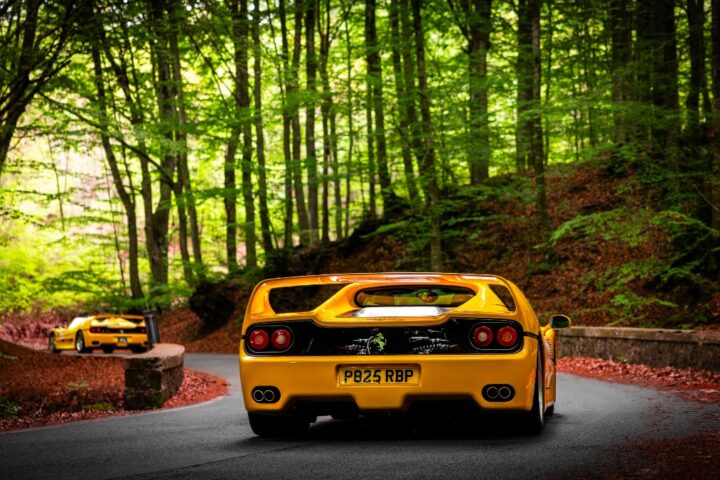In the early 1980s California entrepreneurs Neil Glassmoyer and Mark Goyett founded Modena Design and Development in El Cajon to manufacture the Modena Spyder California, a Ferrari 250 GT Spyder-based sports car that far exceeded the quality and finish of other independent offerings of the time. An early mention of the new creation in a car magazine drew the attention of Hollywood director John Hughes, who was in the planning stages of making Ferris Bueller’s Day Off, in which a valuable sports car would have a pivotal role.
Neil Glassmoyer recalls the day Hughes contacted him to ask about seeing the Modena Spyder. “The first time he called I hung up on him because I thought it was a friend of mine who was given to practical jokes. Then he called back and convinced me it really was him, so Mark and I took the car to his office. While we were waiting outside to meet Hughes this scruffy-looking fellow came out of the building and began looking the car over; we thought from his appearance he must have been a janitor or something. Then he looked up at a window and shouted, ‘This is it!’ and several heads poked out to have a look. That scruffy-looking fellow was John Hughes, and the people in the window were his staff. Turned out it was between the Modena Spyder and a Porsche Turbo, and Hughes chose the Modena.”
“They gave us 4 weeks to build the movie cars,” Glassmoyer recalls. “I always say we built two and a half cars; two were interchangeably used as Hero and stunt cars and one was a rolling fiberglass shell that was used in the destruction scene. This car was actually intended for the stunt work, but both saw action, and both wound up with broken front suspension bolts because the big jump scene took nine takes between the two cars.”
The partners sold Modena Design and Development soon after the release of Ferris Bueller, but in 1988 Neil Glassmoyer leaped at the opportunity to buy back one of the movie cars, which he has owned ever since. Based on the prototype Spyder California design by Scaglietti, the Modena incorporated the original’s steeply raked windshield, inset front turn signals, deep horizontal front grille, prominent hood scoop, front fender vents, and sweeping profile. Beneath the fiberglass skin was a very sturdy rectangular steel tube frame designed by the late Bob Webb, an accomplished Indy car fabricator who worked on Brooks Stevens’ 1952 Excalibur race cars and later on Roger Penske’s all-conquering Zerex Special. Mounting independent front suspension and a solid rear axle with 4-link attachments, a Panhard rod and coil-over shocks, Webb’s chassis was described by Car and Driver as remarkably rigid, more so in fact that many factory convertibles.”
Today this Modena Spyder California is without question the best one extant, Glassmoyer having completed a 10-year restoration in 2010. What started as a very good car has become a truly excellent Grand Tourer with a few key upgrades contribute to that assessment; the original 1963 260 CI Ford V-8 (which allowed the car to be officially titled as a 1963 Modena) has given way to a balanced and blueprinted 351 V-8 bored out to 427 CI and fitted with an Eagle forged steel crank, I-beam connecting rods, forged J&E pistons, Trick Flow twisted wedge aluminum heads and roller rockers. The resulting 500 horsepower launches the 2,650 lb Modena in exhilarating fashion while being kept under control by a refined suspension – comprising independent front A-arms, variable ratio power rack and pinion steering, a 4-link live rear with Panhard rod and Aldan nitrogen-charged adjustable coilovers – and Wilwood power ventilated disc brakes all around.
Scorching Red paint, chromed Borrani wire wheels and a new Tan leather interior combine for a stunning presentation made even more impressive in such details as vintage Smiths instruments, wood-rimmed Nardi steering wheel, authentic hardware and superb craftsmanship. A genuine hand-built GT of the highest quality, this Modena Spyder California is as close as one can come to experiencing the look and feel of an almost inaccessible Italian classic, with the added attraction of being one of the most famous movie star cars of all time.
Source: Mecum

























